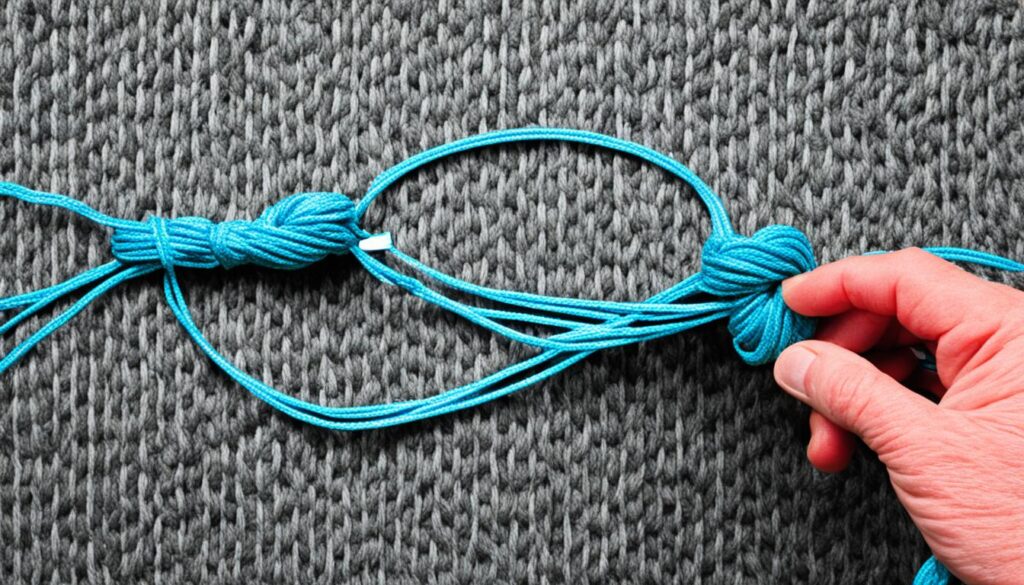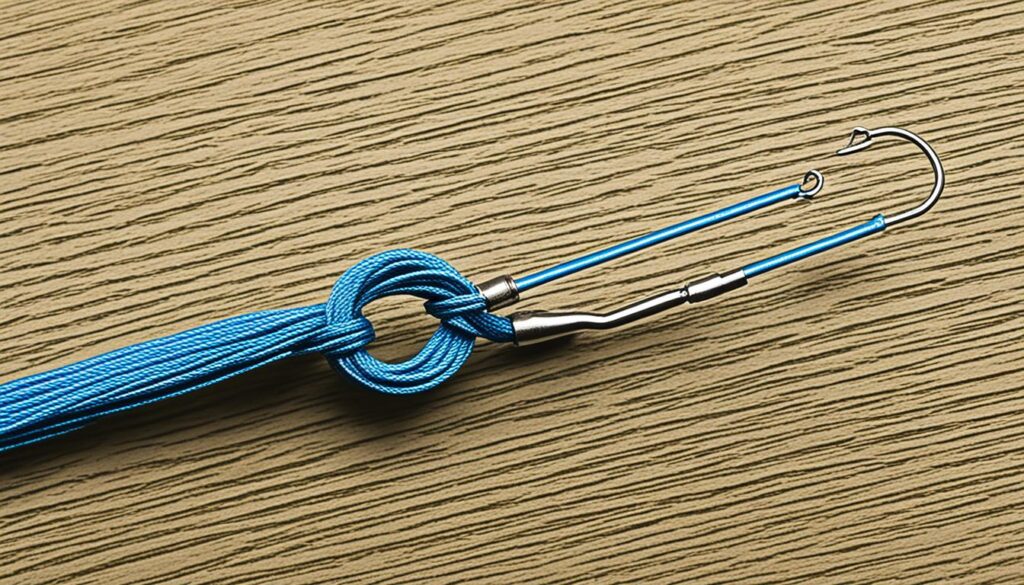Many anglers wonder about tying a loop knot. It’s a simple knot useful for many types of fishing. This knot tying guide shows you how to tie one step by step. Knowing this knot is crucial for all anglers because it’s so versatile.
Key Takeaways:
- A loop knot is a versatile knot used in various fishing techniques.
- Tying a loop knot is an essential skill for every angler.
- Loop knots enhance lure movement and make your bait appear more natural to fish.
- There are different loop knots, but the simple loop knot and the Lefty Kreh knot are popular choices.
- Practice your knot-tying skills to improve your fishing success.
Why Use a Loop Knot for Fishing?
A good knot can change how well you fish. The loop knot is essential for anglers. It makes your lure act more natural. This attracts fish more effectively. Loop knots are great for lures like topwater baits or soft plastics.
The simple loop knot is a favorite among anglers. It’s easy to tie and very reliable. You can quickly learn to make a tight loop knot with this guide.
Benefits of Using a Loop Knot
- Versatile: Works with various fishing baits and methods.
- Natural Action: Allows your bait to move freely, mimicking natural prey.
- Easy to Tie: It’s a knot beginners pick up quickly. Soon, you’ll tie it with ease.
- Reliable: Loop knots are strong and stay put, ensuring your fishing trips are successful.
Adding the loop knot to your fishing skills improves your catches. It’s great for fishing bass or trout. It gives your bait more life, effectively attracting fish.
Still trying to convince? Let’s learn more about the simple loop knot with a demonstration:
How to Tie a Simple Loop Knot: Step-by-Step Guide
Let’s learn a simple loop knot with this guide. Here are the steps:
Pass your line through the eye of the lure or hook.
Double back the tag end and hold it alongside the mainline.
Twist the doubled line around your fingers or hand to create a loop.
Pass the lure or hook through the loop.
Could you work the knot down towards the eye of the hook or lure?
Could you tighten the knot by pulling the tag end and mainline separately?
It’s easy with some practice. This knot works well for fishing. It helps you catch fish. Let’s look at each step closely.
Step 1: Pass your line through the eye of the lure or hook
Start by putting your line through the hook’s eye. Make sure it’s snug and ready.
Step 2: Double back the tag end and hold it alongside the mainline
Next, double the tag end back to the mainline. Keep it tight to avoid slipping.
Step 3: Twist the doubled line around your fingers or hand to create a loop
Then, twist the line to make a loop. The loop must fit the lure or hook easily.
Step 4: Pass the lure or hook through the loop
Could you put the hook or lure into the loop? This starts your knot.
Step 5: Work the knot down towards the eye of the hook or lure
Now, could you move the knot close to the hook’s eye? Wait to tighten it too much.
Step 6: Tighten the knot by pulling the tag end and mainline separately
Finally, make it tight. Pull both ends evenly, but not too tight. This is a perfect knot: neither too tight nor too loose.
Learning how to tie a loop knot is vital for fishing. If you practice, you’ll get good at it. It’s useful for many fishing methods.

Benefits of the Lefty Kreh Knot
The Lefty Kreh knot, also called the non-slip mono loop or Rapala knot, is loved by anglers. It works well with any lure, not just flies, making it a key tool for fishing.
This knot is easy to learn. Even new anglers can tie it. With practice, you’ll find it a quick and secure way to attach your line to your lure.
The Lefty Kreh knot is also solid. It stays reliable, even when reeling in a big catch. This means you can fish with confidence.
This knot boosts your lure’s movement. You can adjust the loop size. This makes your lure look more alive in the water. It attracts fish better, whether you’re using streamers or jerkbaits.
To help you learn, here’s how to tie the versatile Lefty Kreh knot:
- Start with an overhand knot on your line’s tag end.
- Put the tag end through the lure.
- Wrap the tag end around the mainline four to six times.
- Pass the tag end through the loop.
- Tighten by pulling both the tag end and mainline.
- Wet the knot before pulling tight for better hold.
Tying the Lefty Kreh knot is easy with these steps.
Knowing about the Lefty Kreh knot can improve your fishing. Use it to boost your lure’s movement, which can increase your chance of catching fish.

Lefty Kreh Knot Table
| Advantages | Disadvantages |
|---|---|
| Easy to tie | Not suitable for all fishing applications |
| Strong and reliable | May require practice to tie correctly |
| Maximizes lure action | |
| Can be used with various lures |
How to Tie the Lefty Kreh Knot
These easy steps will show you the way to tie a Lefty Kreh knot for fishing:
- Begin with an overhand knot using the tag end.
- Thread the tag end through the lure or fly.
- Twist the tag end around the mainline four to six times. This number depends on your line’s strength.
- Loop the tag end back through the first loop.
- Make sure the knot is tight and secure.
- To make the knot stronger, wet it before pulling it tight.
The Lefty Kreh knot is a great loop knot for fishing. It’s solid and reliable. You can fish confidently with it. It works well with different lures and flies.
Knowing how to tie the Lefty Kreh knot will boost your fishing skills. Your friends will be impressed. Also, you could catch some really big fish. Just keep practicing to become an expert angler!
Conclusion
Tying a loop knot is essential for all fishers, regardless of skill. These knots offer many advantages, such as being versatile, strong, and improving bait movement. You’ll learn to tie these knots well using the instructions in this guide. This will help you catch more fish. Keep practicing and enjoy the benefits of loop knots in your fishing trips.
FAQ
What is the best loop knot for fishing?
The simple loop knot and the Lefty Kreh knot are great for fishing. The simple loop is easy and tight. The Lefty Kreh knot is adjustable and boosts lure movement.
Why should I use a loop knot for fishing?
Loop knots let your lure move freely. This makes it look natural and attractive to fish. They’re best for topwater baits or soft plastics, improving catch odds.
How do I tie a simple loop knot?
To make a simple loop knot, thread your line through the hook’s eye. Fold the tag end over the mainline. Use the loop method to create a loop. Pass the hook through and pull the knot tight.
What are the benefits of the Lefty Kreh knot?
The Lefty Kreh knot is strong and boosts lure action. It fits any lure and lets you adjust the loop size. This optimizes how your lure moves in the water.
How do I tie the Lefty Kreh knot?
To tie the Lefty Kreh, start with an overhand knot at the tag end. Thread the tag end through the lure. Wrap the tag end around the line four to six times. Pull the tag through the loop and snug the knot. Moisten then tighten for a firm knot.
